Matador Network's Blog, page 1150
March 4, 2019
Red Sea Mountain Trail open in Egypt

A new hiking trail just opened in Egypt. The 105-mile Red Sea Mountain Trail will be the first long-distance trail in mainland Egypt, and takes visitors through the remote mountainscapes west of the beachside resort town of Hurghada. Its aim is to give hikers an authentic, rugged Egyptian experience in a part of the Middle East that is largely ignored by tourists, and introduce them to the culture of local Bedouin tribes. The trail is composed of several ancient routes the Bedouin have historically used for trading, traveling, and hunting, and it’s owned by the local Maaza tribe.
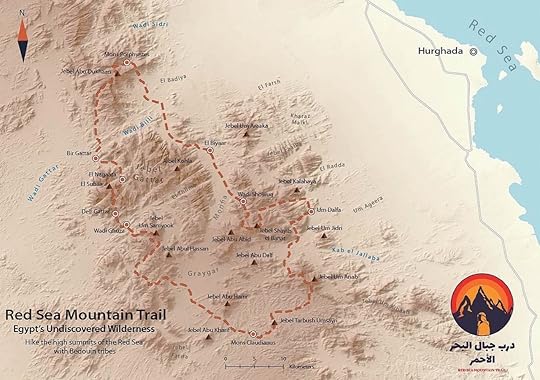
Photo: Red Sea Mountain Trail
One of the trail’s main goals is to create a form of tourism that benefits the Bedouin community and helps preserve Bedouin culture. Ben Hoffler, one of the trail’s founders, told Lonely Planet, “The Red Sea Mountain Trail is about rethinking Hurghada’s tourism and creating an industry in which the Bedouin go from service to leadership roles and which ultimately empowers them to show their homeland and heritage to the world.”

Photo: Red Sea Mountain Trail/Facebook
If a 10-day, 105-mile hike is too much for you, there are shorter and easier circuits within the Red Sea Mountain Trail to accommodate every level of fitness. That said, know that the area is mountainous, so there is serious elevation gain along the way and some parts of the trail involve scrambling. Also, note that you cannot hike this trail independently; a local guide is mandatory for you to explore the ancient land of the Maaza tribe.
According to the official website, “From vast, desert plains to deep gorges and high, rugged summits, and from crumbling Roman towns to prehistoric rock art and chapels of Egypt’s early Desert Fathers the Red Sea Mountain Trail shows the best of the region’s inimitable beauty.”

Photo: Red Sea Mountain Trail/Facebook
The first guided hike along the Red Sea Mountain Trail is scheduled to take place this spring. Updates and further information can be found on the trail’s Facebook page and its official website. 
H/T: Lonely Planet

More like this: 7 underrated sites in Egypt worth visiting, according to an archaeologist
The post Egypt just opened its first long-distance hiking trail and it’s stunning appeared first on Matador Network.

How to avoid a breakup on a trip

The traveler’s rite of passage: a trip with your sweetheart. This is the relationship crash course, the testing ground of compatibility. With relentless together time we start to answer those necessary questions. Can we trust each other in unknown situations? Does more time make us better or worse? When we are too tired for our best selves, who are we really, together? And of course, how much do we fight?
Here’s the good news, traveling couples: It’s not what you fight about or even how you fight. What predicts relational success is the meaning we create about our fights and all the moments in between. All of the obvious arguments will happen while you travel. So pay attention instead to how you treat each other during all that together time and the corrosive, insidious effects that these have on relationships. Here are seven ways to cause a breakup when traveling and how to avoid the pitfalls.
1. Ignoring your partner’s ideas
Don’t be a bulldozer. When traveling with your partner you should look around occasionally and find yourself doing something that isn’t your first choice. If you find yourself living your dream trip and not a shared trip, odds are you’re bulldozing. Relationship bulldozing is when you use unrelenting assertiveness, passive manipulation, or even outright aggression to get your way without acknowledging the other person. If multiple times a day, day after day, you are showing their interests, desires, and opinions don’t matter, then you are likely doing serious relationship damage that will last beyond this trip.
2. Spending all your time with a screen
Your body may be there, but your mind and your face are not. Whether it is for work, media, habit, or boredom, being buried in a screen for most of the trip is guaranteed to drive your partner nuts. In fact, this is one of the most argued about issues on vacation with over half of all traveling couples saying they have argued about a partner not being able to unplug, especially for work. Nobody likes feeling alone when they’re on a trip with their significant other. Turn the device off and remember what eye contact feels like.
3. Blaming your partner for travel mishaps
Being upset and arguing about stressful travel is predictable. Real problems come when contempt sneaks in. Ask yourself this and be honest. How many times have you been stressed and accused your partner of getting stuck in traffic or yelled that you told them not to pick this flight? Yeah, me too. We’re all human. But criticism becomes contempt when we attack who our partner is and act superior. Avoid contempt as much as possible and repair it when it happens because this common travel scenario, when not repaired, is the single greatest predictor of a breakup.
4. Focusing on things that aren’t working
Most people have an image of their ideal vacation and the way things should go. It’s normally a picture of wildly spontaneous, laughing people straight out of some car commercial. You know, the people that we rarely are in our real lives. Those things may happen, but we are ultimately ourselves, still fussing at each other about shared sink space. Sometimes trips themselves aren’t that amazing. They can even be…disappointing (you know it’s true). Hurling idealized expectations at your partner is a guaranteed way to make this trip, and ultimately the “story of us,” a bust. Our brains are wired to pay more attention to negative experiences and when we focus on what’s not working, we create a story of this trip, and perhaps even us, not working too. These typically look like, “but we should be,” “why don’t you want to,” and “if you want this to work then.” Couples trying hard to “rekindle romance” are the prime suspects for this pitfall, but don’t pull rank just yet, it can happen to all of us. Turn the pressure down a notch.
5. Dragging your partner around on your schedule
Unless you are acting as a hired tour guide, slow down. Traveling couples tend to have two set roles: one plans and leads and one agrees and follows. Some couples are more extreme in these roles while others are more balanced. That part doesn’t matter; what matters is how you treat your partner. If you are the planner, make sure you are paying attention to your partner’s energy level. Hanger is real. 22,000 steps in a day is intense. That to-do list is important to you, but it may be a chore for your partner. If you tend to be the partner who is along for the ride, speak up for yourself when you need a change. Storing all the resentment is bad for you and the relationship. If you do speak up and are not heard, time to rethink your traveling companion.
6. Not talking about or respecting limits
There are some trips that are about no limits. Vegas. Carnival. Burning Man. And yet, even with these trips, you need to be very sure of the no rules approach before you leave. More often than not there are limits, even if they are unspoken. These are the most immediate deal breakers with the most immediate betrayals. This can be infidelity, radically different approaches to what “having some drinks” means, or reckless abandon for a previously agreed upon budget. I know it can be a bit of a downer beforehand to communicate expectations, but these trips cause many relationship crashes. If it’s important enough to stay together, talk it out first.
7. Bringing up a trip with your ex
Comparison is natural. You’re thinking about a past trip with a past love while traveling with your new someone. You might be thinking about a great place or experience you had with your ex and want to share that with your new partner but don’t mention the ex. You may be deeply appreciating your new travel buddy compared to the last one, but seriously, don’t mention the ex.
Sure, not everyone is bothered by this, but you would be surprised how much it comes up after the trip, even after years of unmentioned festering. It tells your partner that here, in this “our time” vacation, you still have room in your head for your ex and that your partner’s intimate space is still a shared space. The grateful comparison might play well later, outside of the moment itself. But when you are in the glorious moment that travel makes possible, just be with your partner and don’t bring anyone else into it. 

More like this: The 7 most underrated romantic cities in the world
The post 7 guaranteed ways to cause a breakup when traveling appeared first on Matador Network.

Botox banned from camel contest

We’ve always known that humans have issues with self-image — we go to extreme lengths to improve our appearance and feel more beautiful. But our obsession with beauty might pale when compared with that of the camel owners of Saudi Arabia, many of whom were disqualified from a camel beauty pageant last year for using Botox injections and other cosmetic enhancements. This year, organizers of the King Abdulaziz Camel Festival, which is underway, are taking measures to prevent a similar debacle by instituting strict penalties for camels doctored with beauty products.
The Saudi Camel Club plans to use high-tech equipment to detect plastic surgery, and eliminate them from the competition. It’s more of an issue than you might think, too. Mohammed Alroqi, media director for the Saudi Camel Club, said to Lonely Planet, “So far we have disqualified seven camels for Botox and fillers. And when they are caught, the owner must pay SR100,000 ($26,000) per camel.” He also added that the camel’s owners would be banned for two years from competition.
If suspicions are raised about a camel using Botox, or other cosmetic enhancements, a team of veterinarians will examine the contestant in a medical tent, and use an ultrasound to detect any banned substances like lip fillers or other surgical modifications.
With $30 million in prize money on the line, the camel beauty contest is serious business. Each year thousands of camels come to Rumah, Saudi Arabia to compete. Camels are judged on color, coat texture, leg length, and naturally voluptuous lips. 
H/T: Lonely Planet

More like this: How to get a Saudi visa and what to do once you get there
The post Botox banned from Saudi Arabia camel beauty contest appeared first on Matador Network.

Where is the Eurasian pole
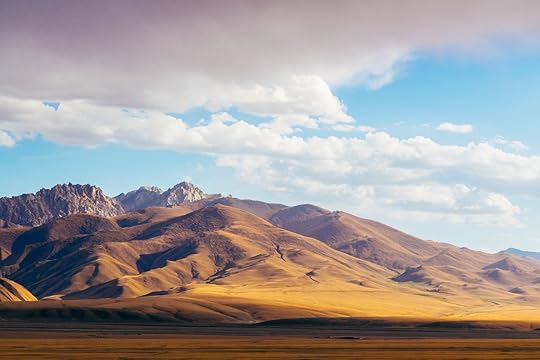
It turns out that the “middle of nowhere” is actually somewhere very specific. Located in the corner of China that is bordered by Mongolia, Kazakhstan, and Russia, the Eurasian pole of inaccessibility redefines the benchmark for “remote.” The farthest point from any sea or ocean on the planet has always been on the bucket list of geography nerds and explorers, and as the name suggests, reaching it is an adventure not without obstacles.
What is a pole of inaccessibility?
The poles of inaccessibility are the points on the map considered most difficult to reach because of their distance from any coastline. But determining how hard it is to actually travel to these locations is subjective, and although some of them are easy enough to visit, others are truly isolated from civilization. Each major landmass has one, with the northern and southern poles of inaccessibility being the least accessible.
In Antarctica, a bust of Lenin emerges from the frozen landscape, looking ahead toward Moscow in what is the southern pole of inaccessibility. In the Arctic, the situation gets even more difficult: with ice-sheets melting due to global warming, the northern pole of inaccessibility does not have a permanent position. Today it’s found at 270 miles from the North Pole, according to expedition group Ice Warrior, but it is not possible to predict where it will be in the future. The Arctic pole of inaccessibility is also the only one yet to be conquered, although British adventurer Jim McNeill has already attempted the mission twice (in 2003 and in 2006), and is planning a third expedition to get to “the last significant place on earth as yet unreached by mankind.”
The American poles of inaccessibility are still pretty out of the way, but at least you won’t have to risk frostbite or fighting a polar bear in order to get there. North America’s pole of inaccessibility is situated near the town of Allen, in South Dakota, while in South America you will need to travel deep into the Brazilian hinterland to reach the municipality of Diamantino and get to the spot most distant from the Pacific and Atlantic oceans.

Photo: Google Maps
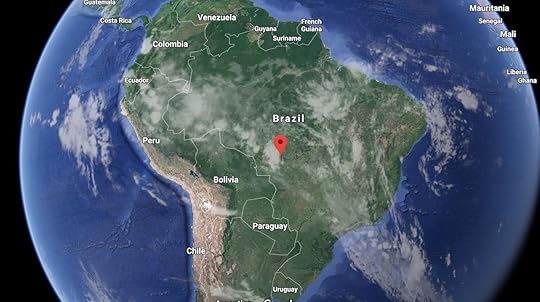
Photo: Google Maps
The African pole of inaccessibility is located in the eastern part of the Central African Republic, near the borders of South Sudan and the Democratic Republic of the Congo. Getting there will not be difficult solely because of the lack of roads, but also for the unstable situation of the region. In Australia, however, you can simply drive to the pole from Alice Springs in less than seven hours.

Photo: Google Maps

Photo: Google Maps
The Eurasian pole of inaccessibility
The Eurasian pole of inaccessibility is unique not only because it represents two distinct continents, Europe and Asia, but also because recent research has found that the original location of the pole may have been miscalculated. Three separate spots share the title now, all in the northern part of Xinjiang, in western China, and all are found at least 1,550 miles from the coastline.
The spot believed to be the Eurasian pole until 2007 is located in the Gurbantünggüt Desert near the border with Kazakhstan, however, this calculation is based on the assumption that the Gulf of Ob is not part of the ocean. By accounting for the Gulf of Ob as part of the Kara Sea, the pole shifts dramatically to the south. The Scottish Geographical Journal proposed two points, called EPIA1 and EPIA2, as the farthest from any coastline in the world, respectively 270 and 97 miles away from the original pole.

EPIA1 (44.29N 82.19E). Photo: Google Maps
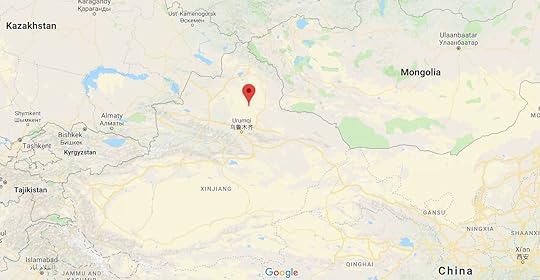
EPIA 2 (45.28N 88.14E). Photo: Google Maps
How to get there
To reach EPIA1 and/or EPIA2, a GPS is essential, as neither is marked. Even with coordinates at hand, however, getting there will be pretty hard considering that the points are not connected by any road or track.
The closest city to both EPIA1 and EPIA2 is Ürümqi, the capital city of the vast region of Xinjiang, home of the Uyghur people. Once a central point on the Silk Road, Ürümqi sits at the end of the Hexi Corridor, the passage opened during the Han Dynasty in 130 BCE that connected Eastern and Western civilizations.
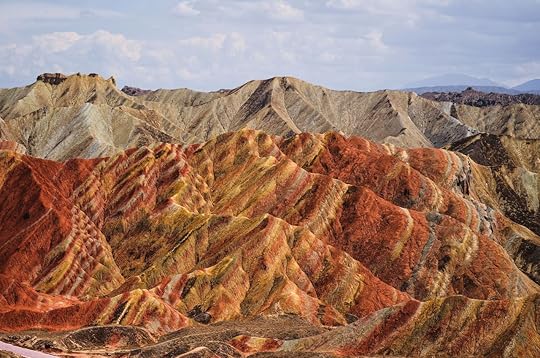
Zhangye Danxia National Geological Park (Photo: Angelo Zinna)
Although it may appear isolated, reaching Ürümqi is fairly easy today from any direction. Coming from coastal China you will have to cross the Gansu province on a long train ride before entering Xinjiang. If you’re starting your journey in Xi’an (home of the terracotta warriors), consider stopping at the Zhangye Danxia National Geological Park, part of the UNESCO-listed Danxia region, where rainbow-colored rock formations await, as well as to Turpan, a historical city on the Silk Road, famous for being one of the few places in the world below sea level. The flaming mountains and ruins of ancient cities in Turpan are seriously impressive and should be considered when planning your itinerary.
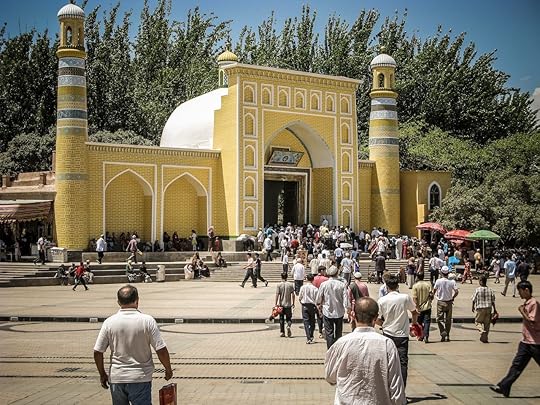
Id Kah Mosque of Kashgar (Photo: Abd. Halim Hadi/Shutterstock)
If you’re traveling from Central Asia, it is possible to enter China via Kazakhstan or Kyrgyzstan. A weekly direct rail connection exists between Almaty and Ürümqi. If you’re coming from Kyrgyzstan, it’s worth stopping in Kashgar, the millennia-old city in the Chinese Far West which has the Id Kah Mosque, built in the 15th century. From Kashgar to Ürümqi, the journey will take between 24 and 30 hours, depending on the type of train you take.

Tien Shan mountain range in Central Asia (Photo: Iryna Hromotsk/Shutterstock)
EPIA1 is found close to the Kazakh border on the Tien Shan mountain range, not far from the Daheyanzi Motorway Interchange in the Bortala prefecture, on the G312 road that connects Ürümqi with Sayram Lake and then Almaty. Although only 18 miles separate the point from the interchange, you will have to climb up an 8,800-foot mountain to say you’ve been there. Definitely not recommended.
To reach EPIA2 it won’t be necessary to pack your mountaineering gear; however, you will have to find your way to the middle of the Gurbantünggüt Desert — the second largest desert in China after the Taklamakan. From Ürümqi the China National Highway 216 crosses the desert to Altay City; your best shot at reaching the Pole, about 100 miles from Ürümqi, is to follow the highway north, to then enter the desert and cross the remaining 50 miles with a four-wheel drive.
Know before you go
Although distances can be huge, traveling by train is a great way to experience China. The rail system is well developed and the trains are clean, comfortable, and still relatively cheap. Unfortunately, foreigners cannot buy tickets online from the official Chinese railway website as a local credit card is required, but many agencies offer this service for a fee. Some of the larger cities such as Beijing, Shanghai, and Xi’an have an English-speaking window at the station, though this is not seen elsewhere. A good idea is to get your hotel to write down what ticket you’d like to buy in Mandarin and hope it is still available.
Most Chinese trains have four classes to choose from, depending on how far you are traveling. For short trips, you can pick a “soft” or a “hard” seat. These labels indicate the first and the second-class carriages, and despite the name, the hard seats are padded. The same goes for overnight rides, where you can select a “soft sleeper” or a “hard sleeper.” The difference is that by buying a soft sleeper ticket you will travel in a four-berth compartment, and with a hard sleeper ticket you will be in an open-plan carriage. A decent mattress, clean sheets, and pillows are provided no matter what class you choose.
The conflict between the local Uyghur population and the central government has caused numerous accidents to happen in Xinjiang over the past decade. Some travel advisory boards still discourage people from going there, but foreigners shouldn’t consider the political situation a reason not to visit. Xinjiang today is a highly policed territory, and apart from the constant checks, it is unlikely that a visitor will be involved in acts of violence.
The arid lands west of the Kazakh border seemed to have been long forgotten by the outside world, but it is changing. The Belt and Road Initiative, the largest infrastructure project ever planned, is transforming the region thanks to the trillion-dollar investment China has employed to reconnect Europe with the Far East. The village of Khorgos, just 80 miles from EPIA1, is set to become an “important node on the global economy” because of its role as a trading connection on the new Silk Road, as reported by The New York Times . What will soon become the largest dry port in the world began its activity here in 2015 and is transforming the tiny Kazakh village to allow Chinese trains to transfer their cargo onto Russian trains and then reach Europe. The World Bank collects academic research done on the Belt and Road Initiative (also known as the New Silk Road), with in-depth information on what is happening in the countries involved in the project. The South China Morning Post has created an interactive guide on the five main projects of the BRI.
A number of useful resources can help you find your way to the Eurasian poles of inaccessibility. Pleco is an app that allows you to easily communicate in Mandarin and translate signs through its OCR technology. Seat61 offers a rich and updated guide to train travel in China. Caravanistan is a comprehensive guide to all Central Asian countries, with first-hand experiences of travelers shared daily on the forum.


More like this: Central Asia is the next big trending destination. Here’s why.
The post How to plan a trip to the Eurasian pole of inaccessibility appeared first on Matador Network.

March 1, 2019
Best things to do in Grinnell, Iowa
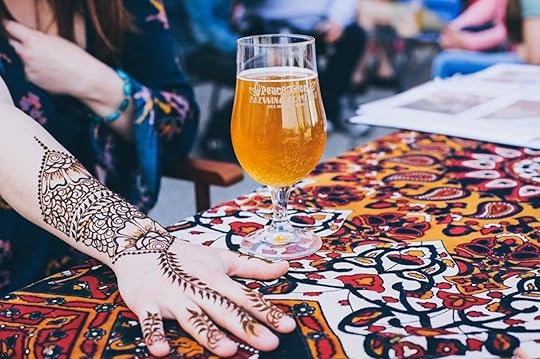
The Midwest tends to get a bad rap in the travel world. Even when publications aim to tout it, a backhanded slight is rarely far away — take Vogue’s write-up on Kansas City, for example. The first four paragraphs amount to “Where? Mississippi?” underscoring the idea that a Midwesterner’s ignorance is intolerance but coastal ignorance? Well, that’s just cute and relatable. The Washington Post sums this phenomenon up nicely with its “You’re Going Where?” series, though it’s kind enough to include places like Raleigh and Boulder.
The hero-goes-on-a-journey structure serves this trope well: Our lone, daring protagonist armed with nothing but fortitude and a pen treads warily into flyover country, making headlines with his or her claim that, as it turns out, decent craft beer is not a high-rent privilege. But those who believe Kansas City “lives differently” or that Fargo has no streetlights are about to have their worldview shattered in two words: Grinnell, Iowa. This town, population 9,027, is the most badass — and overlooked — destination in the state, and perhaps all of the Midwest. Here’s why you need to pull off I-80 to check it out.
The community

Photo: Jacqueline Kehoe
Grinnell is about an hour east of Des Moines, Iowa’s capital city. Just like in nature, Grinnell seems to be subject to the “edge effect” in which two vastly different environments collide. It’s home to both Pete Brownell, former president of the board of the NRA, and a recent 26-day protest for gun control. It’s a farm town with a bustling Monsanto plant that also has a wine bar that passes around cheeky Putin-Trump greeting cards. You can dine at an upscale New York Times-reviewed restaurant or nurse a cheap cup of coffee over a newspaper at the Frontier Cafe.
If you’re familiar with Grinnell, it’s probably due to the college. In addition to its $1.8 billion endowment, one of the largest in the country, it’s among the top-rated liberal arts school in the nation. The average ACT score is 32, leading to its handy moniker The Harvard of the Midwest. And that’s not even mentioning the basketball team: They’re one of the highest-scoring college teams around (this year’s average was 118 points), and they currently hold the NCAA record for the highest scoring player in a single game (137 points). Their run-and-gun style, otherwise known as the Grinnell System, is controversial — and a hell of a lot of fun to watch.
Basketball games are free as are most events in Grinnell. This is on purpose, and you can consider it part of the town’s intrigue.
The arts

Photo: Jacqueline Kehoe
Grinnell’s motto is “The Jewel of the Prairie,” and while that sounds like a slogan you read on an old painted sign on the edge of a field, in this case, the claim’s backed up. The phrase refers to the Louis Sullivan Jewel Box Bank in downtown, a National Historic Landmark that now serves as the visitor’s center — a fitting place to kick off a trip. Architecture fans will recognize Sullivan as the “Father of Skyscrapers,” the man behind Chicago’s Sullivan Center and Buffalo’s Guaranty Building. The jewel design in the stained-glass centerpiece can be found all over town, wherever you can imagine a logo being covertly placed.
Less than a block from the bank is the Grinnell Arts Center. Currently, there’s an exhibit on the incredibly cool Cornelia Clarke who was both a nationally known nature photographer in the 1920s and an Iowan. The center also runs The Stew, a collaborative art space with a maker’s lab, garage, and concert space. Visitors can pop in here whenever though the busiest times are when a Local Artist Market is in full swing.
The piece de resistance is Grinnell College’s Faulconer Gallery, widely known as one of the best small-town art galleries in the country. Right now, you’ll walk into Dread & Delight: Fairy Tales in an Anxious World. It takes all of the stories you know and love and shines a light on their darker sides, calling out misogyny, racism, and homophobia as the villains we cannot escape rather than witches and wolves. Despite the town narrowly voting red, the louder voices here seem to be rainbow, as colorful signs that boil down to “Everyone is welcome here” dot the downtown.
The eats (and brews)

Photo: Jacqueline Kehoe
Once you arrive in town, hike it to Peace Tree Brewing Co. ASAP. Not only is it female-owned, but its famous Blonde Fatale took the Gold Medal for Belgian-Style Ales at the 2014 World Beer Cup. Their website reads, “Our hope is that the beer made under the Peace Tree label will be shared with friends and strangers alike and act as a catalyst for conversations, new friendships, and important agreements — in line with the lore of the Peace Tree of Red Rock.”
For dinner, you have two headlining choices: Prairie Canary and Relish. The former — your downtown, urban, also-does-brunch option — had a write-up in The New York Times spotlighting its (again, female) head chef, the town’s international population, and the need for both down-home comfort food and eclectic, inspiring, out-of-the-box dishes, all sourced from local suppliers. If you get a burger, let me save you from asking the staff how to eat it: You smash it, cut it in half, and pray.
Relish, on the other hand, is open only for dinner by reservation. The giant yellow Victorian is almost out of place for its grandeur, but the town is littered with 1900s beauts — and it’s an apropos space for local food with a sophisticated, global bent. Iowa beef, for example, anchors the Egyptian Beef Stew. Small town assumptions be damned.
If you’ve got time and room afterwards, don’t miss a stop at Solera. It’s the aforementioned wine bar with excellent taste in postcards. The owner, Colleen, routinely goes around asking who would like a fresh-out-of-the-oven chocolate chip cookie. It would seem strange, apart from the fact that customers are talking to each other from opposite ends of the bar, and save for said bar, you might think you’re in Colleen’s house — photos of political figures photoshopped with friends’ faces very much included.
Where to stay

Photo: Hotel Grinnell/Facebook
There’s only one name in the downtown hotel game, and that’s Hotel Grinnell. You wouldn’t want to stay anywhere else anyway. It’s a boutique hotel remodeled from a giant junior high school, and as they say in Kinky Boots, “It’s not what you change in a renovation; it’s what you keep.” The rooms have chalkboards while the Periodic Table — the hotel restaurant — displays the old gym scoreboard. Bikes for rent dot the main hallway, the theater’s fly space has been turned into a loft, and old locker rooms are now bunk rooms that lend themselves to kids’ (or adults’) sleepovers. There’s a huge fire-lit patio for drinks after a day of exploring downtown, hitting up nearby Rock Creek State Park, or one of the two small lakes in town.
Most places you’ll visit are within walking distance of the hotel save for the campus — though that’s doable on a nice day or with one of Hotel Grinnell’s bikes. For more things to do and to check it out yourself, visit Get Into Grinnell or literally send them an email. One of the 9,027 people will actually get back to you. 

More like this: Indianapolis is the new cultural hotspot of the Midwest
The post Why Grinnell, Iowa, is the most badass town in the Midwest appeared first on Matador Network.

What to do in Siem Reap

Phnom Penh is Cambodia’s capital city, but Siem Reap is the country’s capital of tourism and culture. The city is home to the ancient temples of Angkor Wat and is the commercial hub of northern Cambodia and the surrounding section of the Mekong Delta. While Angkor Archeological Park is worth at least a visit, there are plenty of things to do in Siem Reap beyond the temples. The city’s signature pagodas and mellow vibe stand in stark contrast to Southeast Asia’s bustling urban hubs, but that doesn’t mean big city convenience and urban culture are missing. This small city of just under 200,000 is alive and booming. Here’s a rundown of where to go and what to see without ever stepping foot in a temple.
The city’s vibrant nightlife thrives on Pub Street.
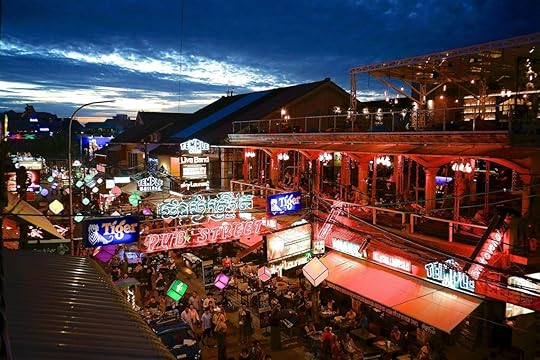
Photo: Wang Sing/Shutterstock
Tourism in Cambodia is booming, rising more than 12 percent last year according to the Phnom Penh Post. Much of that traffic comes from backpackers doing the rounds through Southeast Asia, and once the backpacks are safely locked in hostels, that crowd tends to get thirsty. Siem Reap’s appropriately named Pub Street is where the masses head to quench that thirst. During the day, Pub Street is lined with restaurants and cafés, most of which are extremely overpriced with mediocre food. But at night, the street transforms into a backpacker’s haven of loud music, crowded bars, and 50 cent beer. Temple Club and Yolo Bar blast cheesy pop hits and cater to pub crawls from the nearby hostels, standing as the center of the city’s late-night scene.

Photo: slyellow/Shutterstock
Should the animalistic ways of backpackers on booze not be your scene, make your way to the end of Pub Street to X Bar. Grab a cheap cocktail at the bar, then make your way to the rooftop half-pipe for perhaps the greatest view of Siem Reap’s downtown and a little break from the craziness down below. The music is often better than the typical Pub Street mix, and the bar is frequented by expats and locals as well as tourists.
If you’re craving Mexican food — admittedly an odd craving to have upon landing in Southeast Asia — Viva Restaurant on the opposite corner from the Old Market is a great place to sip on a $1.50 margarita and tacos for the same price. Some of the best people watching is available from Viva’s outdoor seats. For live music, stop by Beatnik downtown or check out The Harbour for open mic night and delicious house spiced rum. Both are frequented by an interesting mix of expats, locals, and tourists and will give you a good sense of life in town.
The Siem Reap experience stretches across town — and beyond.
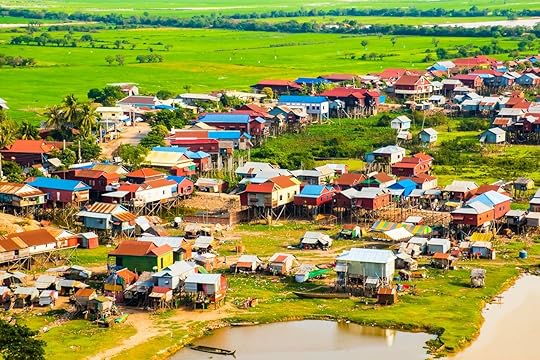
Photo: Pavel Szabo/Shutterstock
Nature lovers can take a trip to the lotus farms of Phnom Krom. A roundtrip tuk-tuk ride costs about $16 and gives you a taste of the lush countryside just outside the city limits. Stop at little huts on the lotus farms for a bite to eat in a relaxing setting, then make your way to the little mountain Phnom Krom for the best sunset views and a temple that actually predates Angkor Wat.
From there, it’s a short jaunt to Tonle Sap Lake, the country’s largest and home to the famed floating villages. For between $30 and $50, you can hire a guide to tour you out to see a floating village. The ride out and back passes rich rice fields and offers a taste of rural Cambodian life.

Photo: Phare, The Cambodian Circus/Facebook
If you’re in the mood for a show, be sure to check out Phare Circus. This mixture of impeccable storytelling and acrobatics inside a small tent is entertaining, with plenty of local history and tradition thrown in. In addition, the ticket revenue goes to support an NGO based in Battambang that takes kids from the street and trains them in the performing arts, and most of the Phare performers you’ll see flipping and twirling onstage in Siem Reap actually started there. Phare is the best way to blend entertainment and a positive impact in Siem Reap.
For the mini-golf enthusiasts, Angkor Wat Putt is just a short tuk-tuk ride through the countryside from the center of town. This temple-themed course is challenging, but free beer awaits those lucky — or skilled — enough to score a hole-in-one. Even if mini-golf isn’t your vision of the ultimate day out, the course is a fun trek through the country’s top attractions.
Check out the markets and chow down on Cambodian food.
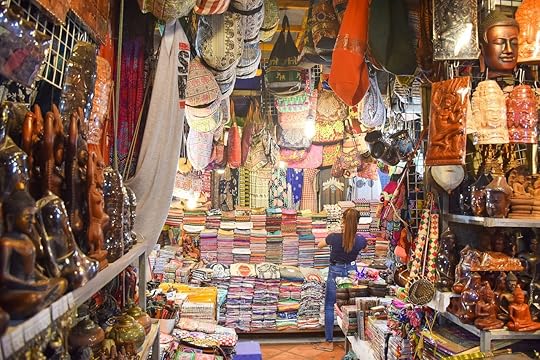
Photo: TEERASAK KHUNRACH/Shutterstock
Many tourists head to Angkor to watch the sunrise. But the local experience happens on the other side of the day. As soon as the sun sets, hop in a tuk-tuk and head to Road 60 where the ticket office for Angkor Wat is. A local market pops up at around 6:00 PM each evening, with plenty of delicious street eats, carnival games, and stands selling trinkets, household items, clothing, and shoes. Wander through this market and you may feel like the only foreigner — there’s not a better place in town to find the perfect souvenir.

Photo: Vassamon Anansukkasem/Shutterstock
Markets happen in town, as well, and a walk through the Old Market or Phsar Leu Market is the best way to experience the crafts and creations of local residents. Treat yourself to a night of tasting street food along the river. Try the amok, steamed pork buns, and most importantly of all lok lak. This dish is iconic in Cambodia and consists of cubed beef squares cooked with tomato, onion, pepper, and cucumber, heavy on the soy sauce and often accompanied by whole leaves of lettuce — a simple but rich dish sure to leave a taste of the Mekong in your memories of Siem Reap. 

More like this: Here’s why Da Nang needs to be on your travel bucket list
The post The coolest things to do in Siem Reap beyond Angkor Wat appeared first on Matador Network.

How to haggle in Morocco’s markets
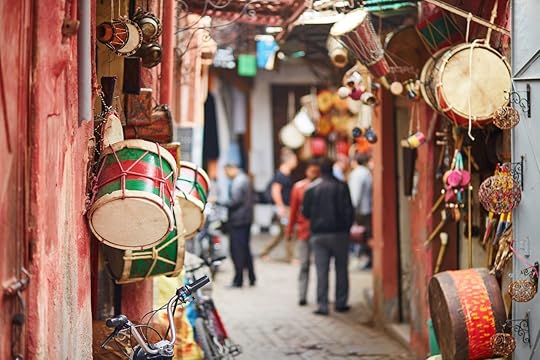
The Moroccan souk, or marketplace, is heaven for the shopaholic. Marrakech, Fez, Tangier, and every other major Moroccan city have extensive markets, usually packed within the walls of a medina, or old city, where cars are banned and foot traffic is dense. Sellers cram themselves into countless alcoves along snaking walkways. Colorful goods hang overhead, burst from every corner, overwhelm the eye. Merchants clamor for attention from passersby, especially anyone who looks foreign with money to spend.
They offer attractive prices, the sellers tell you, the lowest in the medina. In reality, though, these prices are absurdly high. But price-gouging merchants offer something else: the chance to engage in the quintessential Moroccan shopping tradition of haggling.
The only way to arrive at a fair price is to haggle your way down. Don’t look at this as discrimination against tourists. Embrace it not only as a challenge but also as part of the fun. In case the fast-talking sellers of the souk intimidate you, here are a few protips to help you get started.
1. Everything is negotiable.

Photo: KajzrPhotography/Shutterstock
You’ll learn pretty quickly after arriving in Morocco that everything is negotiable. The fare for the taxi from the airport: negotiable. Your breakfast: negotiable. That expensive rug: negotiable. Those cheap refrigerator magnets: negotiable. Depending on how you book your room: negotiable. About the only thing that’s non-negotiable is negotiating. Never pay the asking price.
2. Start low.
As in all negotiations, start low, somewhere south of 50 percent of the asking price. Give yourself plenty of room to budge on price without straying too high. When it comes to the final amount, don’t take anything higher than 70-75 percent of the asking price.
3. Don’t be dissuaded by shows of emotion.
If you ever feel like you’re haggling too hard, remember that the merchants of the souks are hardened salespeople. Sellers may feign offense, rage and sorrow, but those are crocodile tears. You’re dealing with actors of the highest order here. You’re not going to really hurt anyone’s feelings by sticking to a low price or walking away. If anything, you’ll gain respect.
4. But do be nice.
Driving a hard bargain doesn’t require you to shout or swear, so play nice with your fellow hagglers. This applies when you’re walking around the souk as well. If you don’t want to stop at a store where a seller is drawing you in, don’t ignore the seller altogether. Simply say, “no thank you,” and walk on by.
5. Take your time.
Shopping sprees in the US typically last a few hours, but in Marrakech, you’d better be prepared to spend all day, maybe all week, in the market. Even if you skip most shops and pick your battles, you’ll still end up haggling the day away with just a few sellers. Don’t rush it; let yourself drift in the flow of the medina.
6. Don’t lose your cool.
This isn’t the seller’s first rodeo, and the only way to get a decent deal is to pretend like it isn’t yours either. No matter how sickly sweet or dastardly vicious the seller turns when you say no to an asking price, keep your poker face. An enigmatic buyer is a riddle that the seller will work to solve, and the only solution is your price.
7. Bundle items for a group rate.
A single, eye-catching item may attract you to a shop, but as you argue down the price, it’s a good strategy to silently scan the shop for other items you favor. In a pinch, you can bundle items together and try to get a discount on the bunch.
8. Keep your eye on the prize.
On the other hand, don’t let the vendor distract you with items you don’t need. Just because he’ll throw in a pair of shoes doesn’t mean you should overpay for that basket.
9. Walk away.

Photo: Matej Kastelic/Shutterstock
When the seller just won’t budge far enough on the price, summon the strength to walk away. It may seem like you’ve wasted the time spent haggling, but walking away can actually lay the groundwork for future deals if you return to the same shop later in the week.
10. Then come back.
One of the best tactics, if you can pull it off, is to “happen to pass by” the same shop where you left a deal hanging. The seller will know you’re serious about sticking to your price and may be more amenable to meeting a fair demand.
11. Then walk away again.
If you reach a true impasse with a merchant, though, do walk away for real. There are other fish in the souk. 

More like this: My car broke down in the Sahara, and it taught me about trust
The post 11 essential rules to haggling in Moroccan markets appeared first on Matador Network.

Best parks in New York City

While New Yorkers are still cursing the cold winter temperatures and Punxsutawney Phil the groundhog for being wrong about an early spring, visitors can look ahead to the eventual warmer weather. As it comes off so urban and metropolitan, New York City probably isn’t the first place that comes to mind when you think of cities with vast amounts of green space. To the contrary, NYC does both, and it does both well. There are over 28,000 acres of park space all across the five boroughs, so you can get your nature fix in whatever area you find yourself in.
The first park people think of when they think of New York is Central Park, an iconic NYC sight right up there with the likes of the Empire State Building and the State of Liberty. While relaxing in the sun on the Great Lawn, taking a paddle boat out on the lake, and walking around the reservoir are all fine activities in their own right, there are so many other parks that are well worth a visit — and all are near other cool spots that you can combine into an action-packed trip. Here’s our list of five parks you can visit that aren’t Central Park.
1. Fort Tryon Park, Manhattan
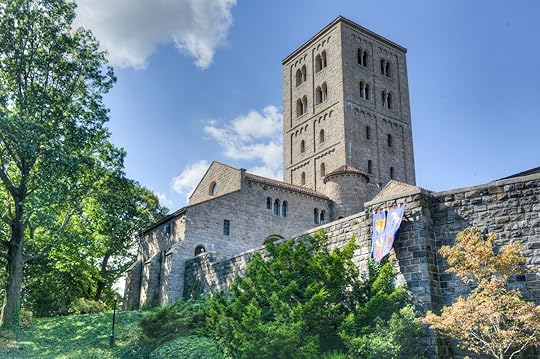
Photo: Felix Lipov/Shutterstock
Fort Tryon Park originally began as John D. Rockefeller Jr.’s vision to create a public park with incredible views. And succeed he did because from any point in the park you’ll find breathtaking scenery, whether it be of New Jersey, the Hudson River, George Washington Bridge, Inwood, or the Bronx. Opened in 1935, the park’s 67 acres are both natural and landscaped. It boasts the largest garden in the city with over 550 plant varieties, the largest dog run in Manhattan, eight miles of pathways for walking or running, workout stations, volleyball and basketball courts, ping pong tables, and playgrounds. The park hosts an hour of morning fitness every Tuesday, Thursday, and Saturday that consists of walking, stretching, and strengthening exercises, all for free. In addition to taking care of your body, it’s a great chance to make some new friends. Once it gets warmer out, the Fort Tryon Trust hosts several other events, such as guided nature walks, historical tours, bird watching, and festivals.
If you’re up for it, you can also visit the Met Cloisters, a branch of the Metropolitan Museum of Art. From the outside, it looks like a medieval castle surrounded by Fort Tryon’s abundant greenery, and the inside provides just as much grandeur. Admission is $25 for adults, $17 for those ages 65 and over, $12 for students, and free for children under 12, and it gives you access to over 5,000 medieval European works.
2. Van Cortlandt Park, The Bronx

Photo: Michael Birts/Shutterstock
Over a thousand acres make up Van Cortlandt Park in the Bronx, making it New York City’s third largest park. The wide, open space means there’s plenty of room to plant yourself down and people watch without hordes of other tourists trying to get a perfect Instagram shot; you’ll be able to see local families having fun and going about their day-to-day lives. Make it a picnic by bringing food with you or stopping into one of the eateries that surround the park’s perimeter — we recommend Lloyd’s for some deliciously mouth-watering cake. There are a number of other things besides people-watching to do, as well. Van Cortlandt is home to the first public golf course in the US, five walking trails, the largest freshwater lake in the borough, horseback riding, and several sports fields ranging from basketball to cricket. Also found here is the Van Cortlandt House Museum, the oldest building in the Bronx having been built in 1748. Now a National Historic Landmark, it was the home of the prominent Van Cortlandt family, who were in the mercantile business, and was used during the Revolution by George Washington.
3. Prospect Park, Brooklyn

Photo: Kostakes/Shutterstock
If you go to Brooklyn and want to visit an actual park with tons of green space, Prospect Park is the park to go to. Designed by the same team behind Central Park, it’s bordered by five different neighborhoods. It encompasses 585 acres, and there are a variety of activities to suit all ages. On one end is Grand Army Plaza, one of the first parts of the park to ever be built, which marks the beginning of the world’s first parkway. Across from it on the other end is the Brooklyn Museum, holding over a million different artworks and antiquities. Close by is the Brooklyn Botanic Garden, famous for its annual spring cherry blossom festival. For families with kids, there’s the Prospect Park Zoo and carousel. In addition, there are sporting facilities, walking trails, running paths, and scenic picnic areas.
4. Flushing Meadows Corona Park, Queens

Photo: MISHELLA/Shutterstock
Flushing Meadows is beloved by the locals who visit it once the cold takes a hike, but it’s famously known by out-of-towners for the US Open Tennis Championships held on its grounds every year, as well as Citi Field stadium where the New York Mets baseball team plays ball. But besides national sports, the 897-acre expanse held the 1964-65 World’s Fair, where hundreds of businesses showcased different cultural and technological innovations. One of the remaining elements of it that you can still see today is the Unisphere, a giant stainless steel model of the Earth that was dedicated to the dawn of the space age as well as the fair’s theme of “peace through understanding.” Other than that, there’s the Queens art museum, the New York Hall of Science museum, an aquatic center, golf course, and a zoo.
5. East River State Park, Brooklyn

Photo: gabriel12/Shutterstock
At 11 acres, East River State Park is unlike the other parks on this list. It’s small, but good things come in small packages. What this waterfront park lacks in size, it more than makes up for in gorgeous scenery as you’ll get quite the view of the Manhattan skyline. It’s a great area for a picnic or to just sit on the grass and soak in the atmosphere. You may want to hold off on bringing your own food, though, because once spring rolls around, the Smorgasburg food festival happens every weekend. The name is a combination of the word smorgasbord and Williamsburg, the neighborhood it’s held in, and it truly lives up to the name — over 100 vendors serving up food from across the globe, as well as new twists on classics, take part. The best advice: Come hungry. 

More like this: The 8 best food spots only NYC locals know about
The post 5 NYC parks you should visit that aren’t Central Park appeared first on Matador Network.

Airport Mailers ships TSA items

TSA agents could probably start a pretty interesting museum with all the items they’ve seized from passengers in security lines. Now, however, those items won’t just disappear into TSA’s abyss of confiscated goods but can actually be mailed back to you. Airport Mailers has been around since 2003, but it’s in the midst of establishing a firm and growing nationwide presence, having expanded to 28 airports around the US. Airport Mailers offers travelers a way to safely send items home from the airport.
If you’ve arrived at the airport and realized that you accidentally packed something that won’t make it through security, simply visit the Airport Mailers checkpoint, place it in a 6×9″ plastic pouch, pay the fee, complete a shipping form, and mail it home.
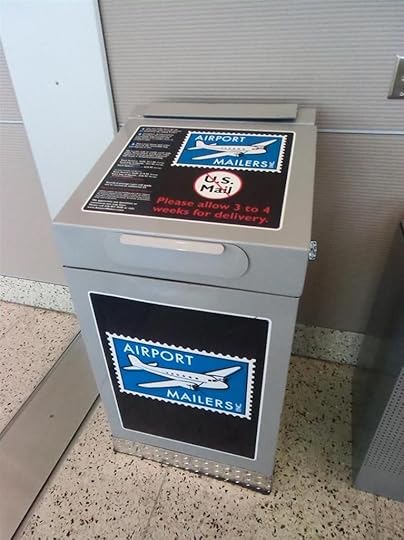
Photo: Larry Motschenbacher/Facebook
According to the website, the goal of Airport Mailers is “to provide the easiest, most convenient and cost-efficient manner for travelers to keep their possessions by mailing them home.”
Shipping fees are $8-9 for items sent within the US. Be aware that certain items, like lighters, may cost more. The service also does not ensure shipments, so there is a small chance your item could be lost in transit. 
H/T: Departures

More like this: Where to buy all the fancy items the TSA confiscated from other people for cheap
The post This service lets you mail home items TSA won’t allow on your flight appeared first on Matador Network.

Traditional Mardi Gras foods

Mardi Gras, Carnaval, Fat Tuesday — whatever you call it, the day before Ash Wednesday and the start of Lent is a time of eating and drinking in excess. Religious or not, people who attend Mardi Gras parties see levels of consumption matched only by holidays like Thanksgiving, only a much, much rowdier Thanksgiving.
Mardi Gras is French for Fat Tuesday (the 47th day before Easter), but the total season is longer than just one day. The season technically starts on January 6, the Christian holiday of Epiphany that’s also known as Three Kings Day or the Twelfth Day of Christmas. A wider term, Carnaval (or Carnival, depending on the country), is used in Brazil, Italy, and countries around the world to reference the entirety of the time between January 6 and whichever day Mardi Gras lands on. Carnaval is loosely translated to “farewell to meat,” a reference to the food traditions that the holiday started on.
The holiday dates back to pagan celebrations of the end of winter, the coming of spring, and all the fertility and babies that spring connotes. The celebrations were adapted by the Catholic Church as a time of excess prior to the banning of food from warm-blooded animals, alcohol, sex, and anything fun during Lent.
It’s not just Catholics and Christians who celebrate today. It’s been adopted and adapted by the secular population as a giant party, with Carnaval festivities taking place from Rio de Janeiro (considered the largest festival in the world) to Venice to Quebec City. It’s known as Karneval, Fastnacht, or Fasching in Germany and Fastevlan in Denmark. Some Slavic nations call it Fasiangy while Russia calls it Sedmica Syrnaja, or “butter week.” The party has spread as far as Catholicism and Christianity, and no matter what it’s called, it’s a ruckus filled with too much eating and too much drinking.
Mardi Gras and Carnaval foods can be pretty much anything, but one of two factors generally make a dish stand out as something that’s stood the test of time. The first is that the dish is particularly indulgent when it comes to meat and dairy, neither of which can be eaten again until Easter, and the second is that the food has a celebratory, and in some cases sexual, connotation. These are some of the most famous Mardi Gras and Carnaval dishes and foods to know.
1. King Cake

Photo: Ivana Lalicki/Shutterstock
King cakes date back to early France and Spain and the Catholic celebration of Epiphany, or Twelfth Night, that happens on January 6. The night symbolically represents when the three wise men met baby Jesus after his birth. The cakes were associated with the days between Epiphany and Ash Wednesday, the start of Lent, sometime in the Middle Ages.
Today, the cake is still enjoyed around the world on Mardi Gras. In France, it’s called galette des rois (“cake of kings”), and in Spain it’s called rosca de reyes. The Portuguese call the cake bolo rei. King cake goes by different names around the world, but each has something hidden inside. Some countries, like France, go with a bean. In the US, it’s generally a plastic baby, a tradition that started with a bakery called McKenzie’s in New Orleans in the 1950s. Tradition holds that whoever finds the baby has to buy the next cake or host the next party.
King cake is far and away the most popular Mardi Gras food in the US, particularly in New Orleans and Louisiana. If you’re not heading south for the holiday, the good news is that many of the best king cake shops in Louisiana ship their goods so you can still get a taste.
Wherever you get your cake from, you’ll notice that almost all your options are covered in purple, gold, and green sugar or icing. Those are the city’s traditional Mardi Gras colors set by Rex, one of the oldest Mardi Gras krewes that has been participating in parades since 1872.
2. Pancakes

Photo: Chantal2821/Shutterstock
Mardi Gras has another name that’s more direct about the food reference: Shrove Tuesday, also known as Pancake Day. Held on the day before Ash Wednesday, Shrove Tuesday is traditionally when Christians in England went to confession to be absolved from their sins (or “shriven”). It was the last day that the devout could eat meat products until Easter 47 days later, giving everyone one more chance to use up all their eggs, dairy, and animal fat. You know what uses a lot of eggs, dairy, and fat? Pancakes.
Today, Pancake Day is primarily celebrated in the UK, Ireland, Australia, and Canada. While the idea behind it has changed with modern times, people still worship the pancake. The town of Olney in the middle of England has held a pancake race — an event where local women wear a skirt and race while flipping a pancake — since 1445.
3. Cannoli

Photo: Harmony Waldron/Shutterstock
Cannoli (singular: cannolo) were invented in Sicily in the Middle Ages. They were originally made by wrapping a flat piece of dough around a sugarcane stalk, which was brought by conquerors from the Middle East, and then frying it. The shell was then stuffed with fresh sheep’s milk ricotta cheese. The cheese came easiest in the spring around the same time as the final days of Carnaval, and the treat became associated with the holiday. The phallic cannoli were also associated with fertility, further endearing them to the free-for-all debauchery of pre-Lent days.
Cannoli were sold around Italy during Carnaval throughout Middle Ages, including in Venice, which is still to this day known for its celebration. Today, however, they’re sold year-round, and the fillings aren’t limited to fresh sheep’s milk ricotta.
4. Doughnuts

Photo: BarthFotografie/Shutterstock
Krapfen, a type of round doughnut filled with jam, are to Austria what king cakes are to Louisiana. In a similar way that pancakes were made to use up the eggs, dairy, and lard in England, krapfen are made to empty the larder for the Carnaval celebrations in Austria and parts of the former Austro-Hungarian empire.
Jelly- or jam-filled doughnuts are also popular in Germany and go by different names depending on where they’re served. It’s krapfen in southern and central Germany, kreppel or kräppel in central Germany, fastnachtsküchelchen (“little Karneval cakes”) in the Rhineland, and Berliner in northern Germany. In Berlin and East Germany, the doughnuts are called pfannkuchen, which means pancakes in other parts of the country.
Carnaval is just as much about tricks and one last bit of fun before Lent as it is about eating. In Germany, both are combined. Beware of a common prank where a doughnut is filled with mustard and placed alongside the sweet versions, just waiting for someone to take a bite and be extremely disappointed.
Scandinavian countries often serve a jelly- or whipped-cream-filled doughnut during Carnaval as well. They’re called semla in Sweden and are mixed with cardamom and filled with almond paste.
Denmark and Norway have fastelavnsboller, which can be traced back to the pagan spring fertility celebration of Fastelavn. Blossoming birch trees signaled the fertility of the season, and those that didn’t blossom were considered to have the fertility inside waiting to wake up. (The birch branches were later associated with Christ when Christianity came to the area.) On the Sunday before Ash Wednesday, children would get up early and whack their parents with birch sprigs. In return, they’d get the fastelavnsbollers filled with whipped cream and covered in sugar. Denmark celebrates similarly on that Sunday, when kids go door to door singing ”boller op, boller ned” (buns up, buns down). If they don’t get their buns (the fastelavnsbollers) then they’ll make trouble.
5. Cheese

Photo: Nina Firsova/Shutterstock
In Greek Orthodox traditions, when certain foods are given up is staggered. The last Sunday before the start of Lent is officially called the Sunday of Forgiveness. Meat is already off the table that Sunday, but thanks to an indulgence in everyone’s favorite dairy product, it’s also known as Cheesefare Sunday. That Sunday is the last day that people following the Orthodox religion can eat dairy until Easter.
In Romania, Cheesefare is celebrated with papanasi, which is like a sweet and savory doughnut that’s filled with soft cheese. The devout in Ukraine eat nalysnyky, or crepes that are filled will a soft cheese.
6. Capirotada

Photo: Esdelval/Shutterstock
While much attention is given to pre-Ash Wednesday meals and what you can’t eat, what you can eat during Lent is just as important to the symbolism of the reason for Mardi Gras as a whole. Sundays, after all, are basically the cheat days of Lent when people are allowed to indulge in otherwise forbidden food. In Mexico, the cheat dish of choice is a bread pudding made with a clove and cinnamon sugar syrup called capirotada. Capirotada, like the Catholic religion itself, was brought to Mexico by Spanish conquistadors. It’s not an entirely Spanish (or even Catholic) food, however. The spices show Spain’s Moorish influence from when the Moors ruled parts of the Iberian Peninsula from 711 to 1492.
Religious Spaniards gave the Moorish spices religious symbolism, the Chicago Tribune explains. The bread stands for the body of Christ, the syrup for Christ’s blood, the cloves for the nails in the crucifixion, the cinnamon sticks for the wood of the cross, and the cheese put on top for the holy shroud. Today, capirotada may also include dried or fresh fruit and nuts, as well as any amount of sprinkles you desire. 

More like this: Everything you need to know before you go to Mardi Gras this year
The post The 6 foods you need to know to understand Mardi Gras appeared first on Matador Network.

Matador Network's Blog
- Matador Network's profile
- 6 followers



